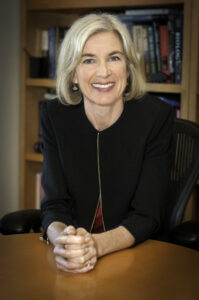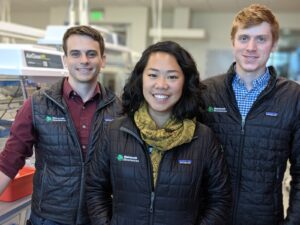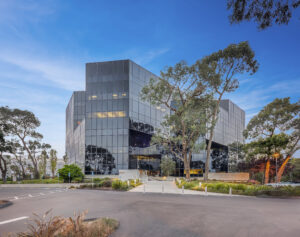
In just four years Mammoth Biosciences, whose co-founders include 2020 Nobel laureate Jennifer Doudna, PhD, has grown to a “unicorn” valuation of more than $1 billion, thanks to $195 million in new financing completed in recent months.
Mammoth, a growing developer of CRISPR-based diagnostics that is also stepping up efforts to develop in vivo genome-edited therapies, has completed $150 million in Series D financing, in addition to a $45-million Series C round raised late last year. Both financings, announced Thursday, bring Mammoth’s total capital raised from investors to more than $255 million.
Another big name—Amazon—joined the Series C round, which was led by Redmile Group and Foresite Capital, and included previous investors. Redmile alone led the most recent financing, with participation from investors that included Foresite as well as Senator Investment Group, Sixth Street, Greenspring Associates, Mayfield, Decheng Capital, NFX, and Plum Alley.
“It’s a marker of how far Mammoth has come, but it’s still early days for what we can do,” Mammoth CEO Trevor Martin, PhD, told GEN Edge. “What’s really exciting is that both within diagnostics and therapeutics, we’ve seen a ton of progress in these technologies, but there’s still some kind of potential on the table to explore there.”
However, Martin offered few details of the company’s progress in diagnostics and genome-edited therapies. He said the company has no public timeframes for launching its DETECTR™ test or identifying a lead candidate and submitting filings for its in vivo genome-edited therapies, saying only that the company would focus on developing therapies that offer permanent genetic cures for various diseases.
Mammoth has identified several potential therapeutic areas for its treatments—including autoimmune diseases, cardiovascular, hematology, immuno-oncology, liver disease, neurology and neuromuscular diseases, and ophthalmology—but has not pinpointed where it will focus its drug development efforts first.
Both Mammoth’s therapies and diagnostics will be based on what the company touts as the largest toolbox of CRISPR proteins on earth. Through the financing, Mammoth plans to expand the toolbox and broaden its pipeline of genome-edited therapies, none of which have been made public.
From its toolbox, Mammoth said it will focus its genome-edited therapy efforts on the smallest known CRISPR systems, based on Cas14, which targets single-stranded DNA and was discovered by Doudna’s laboratory at the University of California, Berkeley; and Casɸ, which is encoded exclusively in the genomes of huge bacteriophages. CasΦ was also discovered and characterized by Doudna’s laboratory, and was detailed in “CRISPR-CasΦ from huge phages is a hypercompact genome editor,” published last year in Science.
Small lengths, huge implications
Their relatively small sizes—530 amino acids for Cas14a and 757 amino acids for Casɸ-2—are less than half those of commonly used variants of Cas9 [1368 amino acids for SpCas9] and Cas12 [1,300 amino acids for FnCas12], offering numerous potential advantages for the therapies Mammoth plans to develop, Martin said.
“This has huge implications for therapeutics,” Martin said. “Whether using AAV or LNP (lipid nanoparticles), there can be advantages to having small systems where with AAV, you have a certain amount of packaging. Instead of filling up the whole freight truck with just the Cas protein, you’re filling just a fraction of it. That leaves additional cargo space for anything else you might want that’s critical for actually delivering the therapy, whether that’s the guide RNAs or CRISPR-plus applications such as CRISPR activating, CRISPR inhibiting, base editing, etc.”
Previously, Mammoth has discussed also working with Cas12, which targets double-stranded DNA; and Cas13, which targets and recognizes single-stranded RNA. The company is also working with other Cas enzymes which it has yet to disclose.
“We’re always pushing the envelope of what’s possible in CRISPR,” Martin said.
Mammoth has applied Cas12 in its COVID-19 diagnostic effort which culminated in the SARS-CoV-2 RNA DETECTR Assay, a COVID-19 diagnostic for which UCSF Health Clinical Laboratories was granted an FDA Emergency Use Authorization (EUA) in August 2020. The 45-minute test is designed to detect nucleic acid from SARS-CoV-2 in upper respiratory specimens. The test extracts, isolates, and purifies SARS-CoV-2 nucleic acid for simultaneous reverse transcription into cDNA, followed by amplification using loop-mediated amplification (RT-LAMP).
The SARS-CoV-2 RNA DETECTR Assay was co-developed by Mammoth through its partnership with UCSF professor Charles Chiu, MD, PhD, who is also director of the UCSF-Abbott Viral Diagnostics and Discovery Center, and a member of the company’s Scientific Advisory Board. Mammoth in 2019 exclusively licensed two U.S. patents granted to the regents of the University of California that cover CRISPR collateral cleavage diagnostic systems.
In July 2020, Mammoth won funding for its development of a scalable COVID-19 test, when the company was awarded $23.1 million of $248.7 million in contracts to the first seven lab-based and point-of-care tests diagnostics developers funded through the NIH’s Rapid Acceleration of Diagnostics (RADx) initiative. The testing system can be adapted to detect for other viruses, though Mammoth has not made public which ones.
Scaling up
Late last year, Mammoth signaled its intent to develop, scale-up, and commercialize its molecular diagnostic assay for COVID-19 through partnerships with MilliporeSigma and Hamilton. MilliporeSigma will serve as contract manufacturer for Mammoth’s DETECTR BOOST™ SARS-CoV-2 Reagent Kit, a high-throughput testing system designed to leverage standard, automated liquid handling equipment from Hamilton to allow rapid processing of both nasal swab and saliva samples.
Mammoth is also applying its DETECTR™ platform toward the development of CRISPR-based diagnostics and biosurveillance technologies against varied disease threats for the U.S. Department of Defense (DoD). Mammoth and IDbyDNA—whose proprietary pathogen database and algorithms Mammoth is applying in those tests—are among subcontractors under a four-year, up-to-$36.7 million contract signed by DoD’s Defense Advanced Research Projects Agency (DARPA)with prime contractor MRIGlobal, which announced the contract in January.
The contract enables DARPA to carry out its Detect It with Gene Editing Technologies (DIGET) program. DIGET calls for developing a massively multiplexed detection (MMD) device for 1,000 or more targets—as well as a hand-held, disposable point-of-need device for detection of at least 10 targets—both pathogens and host biomarkers. Mammoth is primary subcontractor to MRIGlobal for the point-of-need device, and will contribute to development of the MMD platform.
In May 2020, Mammoth launched its collaboration with GlaxoSmithKline’s GSK Consumer Healthcare to develop a handheld test designed to apply the DETECTR platform at point of need. “I can’t say too much about it, but definitely we’ve made huge strides,” Martin said, adding that no timeframe has been made public.
“I think the secret sauce is definitely having that deep CRISPR expertise, combined with top-tier engineering and chemistry, and the sort of expertise of doing full stack diagnostics,” Martin said. “It’s not just the CRISPR chemistry. It’s that combination of that with everything else.”
DETECTR is not limited to infectious disease in its targeting of any DNA and RNA, he added.
“Since the beginning of Mammoth, we’ve definitely been really excited about applying it to infectious disease, even before the pandemic,” Martin said. “The pandemic really just accelerated work that we were doing with COVID now as a target of course, because we’ve always thought that that can be a very transformative area. I think in particular, infectious diseases is a space where it’s really important to be able to have high quality results anytime anywhere.”
Following North Stars
“Similar to how our North Star on the therapeutic side is in vivo permanent genetic cures, our North Star in the diagnostic side is democratizing access to high quality molecular information. And I think infectious disease is really one of the kinds of clear areas, you can have a huge impact on that type of goal,” Martin added. “That’s why a lot of our work has been an infectious disease space but it’s definitely by no means limited to that.”

Martin and Doudna co-founded Mammoth with Janice Chen, PhD, the company’s Chief Technology Officer, who discussed her company’s technology last year on GEN’s monthly “GEN Live” program; Lucas Harrington, Mammoth’s CSO; and Ashley Tehranchi, PhD, who served as CTO until May 2019.
Mammoth is among several companies to receive EUAs for CRISPR-based COVID-19 diagnostics. The first was Sherlock Biosciences, which in May 2020 received FDA emergency authorization for its Sherlock CRISPR SARS-CoV-2 Kit.
“It opened up the world, and the market, to accept CRISPR as having arrived for use in healthcare,” Sherlock’s co-founder and then-CEO Rahul Dhanda told GEN in May. “The initial EUA allowed us to validate this robust technology as something that is rapidly deployed and suitable for use in a number of different formats and settings. And that product then became the licensed asset that has served as the backbone of several deals which are now becoming different embodiments of that product,”
Dhanda stepped down as CEO in July, succeeded by Bryan Dechairo, PhD, previously executive vice president of clinical development with Myriad Genetics—though Dhanda remains a board member through year’s end, and will be a strategic advisor next year. The company at deadline had not replied to a GEN query about the effect of the change on development of Sherlock’s technology and tests.
Elementary, Watson
The diagnostic applies Sherlock’s Specific High-sensitivity Enzymatic Reporter unlocking (SHERLOCK) technology, for which the company is named. Sherlock’s co-founders include Feng Zhang, PhD, of the Broad Institute, who chairs the company’s advisory board. In July 2020, Sherlock Biosciences and binx health entered a partnership announced as intended to develop the world’s first point-of-care diagnostic test for leveraging CRISPR technology.
Sherlock and Mammoth were granted their emergency authorizations months before Mesa Biotech’s EUA, granted in January for its CRISPR-based Accula SARS-CoV-2 Test, developed under a $561,000 BARDA contract awarded in March 2020. The palm-sized test designed to deliver qualitative, visual detection of nucleic acid from SARS-CoV-2 in throat swab and nasal swab specimens within 30 minutes. Mesa has since been acquired by Thermo Fisher Scientific for up to $550 million, in a deal completed February 26.
Mammoth emerged from stealth mode in April 2018, disclosing plans to develop an easy-to-use and affordable point-of-care test enabling fast, simultaneous detection of multiple conditions, in real-time, both in the hospital and at home, through a single credit card-sized strip form factor. Mammoth raised $23 million later that year to fund the initial development of the test, later completing a $45 million Series B financing.
Mammoth said that in addition to accelerating development of its diagnostics and in vivo gene edited therapies, the financing will also enable it to continue expanding its staff.

The Brisbane, CA-based company has grown to more than 110 employees, Martin said. Among the most recent hires is Gary Loeb, JD, who has been appointed the company’s General Counsel. Loeb has more than 20 years’ experience in biotechnology legal, intellectual property and regulatory positions, and previously served as general counsel at Sangamo Therapeutics. Among his earlier positions was vice president of intellectual property at Genentech, a member of the Roche Group.
“His addition obviously strengthens the executive team, but more broadly, I think it kind of goes towards this story of one of the core things that makes Mammoth unique as well,” Martin said. “It’s really this combination of kind of scientist-founders and super experienced biotech executives, and the mesh of that together is what allows us to challenge the status quo.”







